Email campaign best practices: The ultimate guide to being a successful email marketer
Published on April 16, 2025/Last edited on November 11, 2025/14 min read
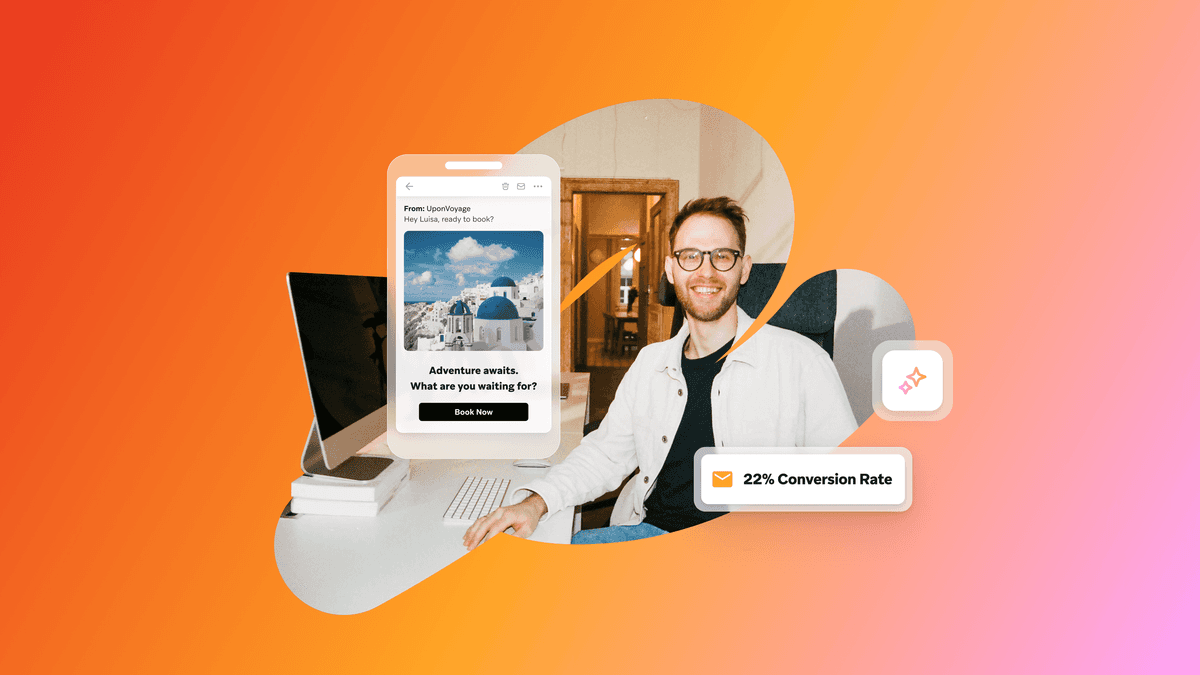

Team Braze
A person’s inbox is a sacred place. It's a direct line of communication where brands can build meaningful connections and lasting trust—but it’s also crowded, competitive, and often overwhelming. To truly stand out, marketers need to understand and apply email campaign best practices.
While email marketing might not be the newest tool, it's can be one of most valuable channels when done right. So, how do you make sure your emails break through the noise and resonate with subscribers? Let's explore exactly that.
In this article we’ll discover:
- What is email marketing?
- When to use email marketing
- How to create an email strategy for conversions
- Successful marketing campaigns with personalized email examples
- Effective email marketing tips
- How to apply cross-channel marketing email best practices
- Measuring success: Key metrics to track
- Email marketing FAQs
- Final thoughts
What is email marketing?
Email marketing is a powerful digital marketing strategy where businesses communicate directly with current and potential customers via email. It involves sending messages to your audience in a way that nurtures the relationship, drives engagement, increases sales, or encourages customer loyalty.
Effective email marketing campaigns can range from promotional emails highlighting new products and discounts, to informational newsletters designed to educate or provide value to subscribers.
Unlike social media or paid advertising, email marketing offers a more direct line of communication with audiences who have explicitly expressed interest by subscribing. It offers the chance for brands to deliver personalized, targeted content directly to an individual's inbox, and can result in higher ROI.
Email marketing also plays a vital role in customer retention, as it keeps the conversation going beyond the initial purchase. Through consistent communication, trust can be built, encouraging repeat business, loyalty, and advocacy.
When to use email marketing
Email marketing is ideal for situations where you have a clear, direct message to deliver to a targeted audience who have already expressed interest in your brand, products, or services. There are different types of email you can utilize and here are some scenarios where email is particularly effective:
1. Building customer relationships
Use marketing emails to nurture existing customers or subscribers by regularly offering valuable content. This might include newsletters, educational content, or company updates that keep your audience informed and engaged.
2. Promoting products and offers
Emails are great for announcing new products, special offers, seasonal sales, or limited-time discounts. This can drive traffic, increase sales, and boost conversion rates.
3. Onboarding and customer education
When someone subscribes or makes their first purchase, email is often ideal for onboarding campaigns, guiding users through initial experiences, and helping them get maximum value from your offerings.
4. Re-engagement campaigns
If subscribers have become less active or haven’t interacted recently, targeted email campaigns can re-capture their interest, prompting renewed engagement.
5. Customer retention and loyalty programs
Email marketing helps maintain long-term customer loyalty through targeted communications, loyalty rewards, and personalized offers designed to encourage repeat business.
6. Feedback and surveys
Using email to solicit customer feedback, reviews, or testimonials is great for improving your offering and showing customers their opinions matter.
Whenever your goal is to build meaningful relationships, communicate directly, and drive measurable results, email marketing should be part of your strategy.
How to create an email strategy for conversions
Creating a successful email marketing strategy involves careful planning, clear objectives, and thoughtful execution. Here's a step-by-step approach:
1. Set clear objectives
Start by defining what you want your email marketing campaigns to achieve. Objectives might include increasing brand awareness, generating leads, boosting conversions, improving retention, or enhancing customer loyalty. Specific goals help you measure success and guide your decisions.
2. Identify your target audience
Know precisely who your emails are for. Segment your audience by demographics, behaviors, preferences, or past interactions. Clarity helps your messaging to resonate and deliver genuine value to each segment.
3. Choose the right email types
Not all emails are the same. Decide whether you'll use newsletters, promotional emails, automated drip campaigns, welcome emails, transactional emails, or a mix of these, based on your goals and audience preferences.
4. Build creative, compelling emails
Your email content should be relevant, valuable, and engaging. Pair the right kind of copy with visually appealing designs that align with your brand. With Braze AI Copywriting Assistant and Image Generator, you can more easily keep your messaging clear, your calls to action (CTAs) strong, and experiment with different creative.
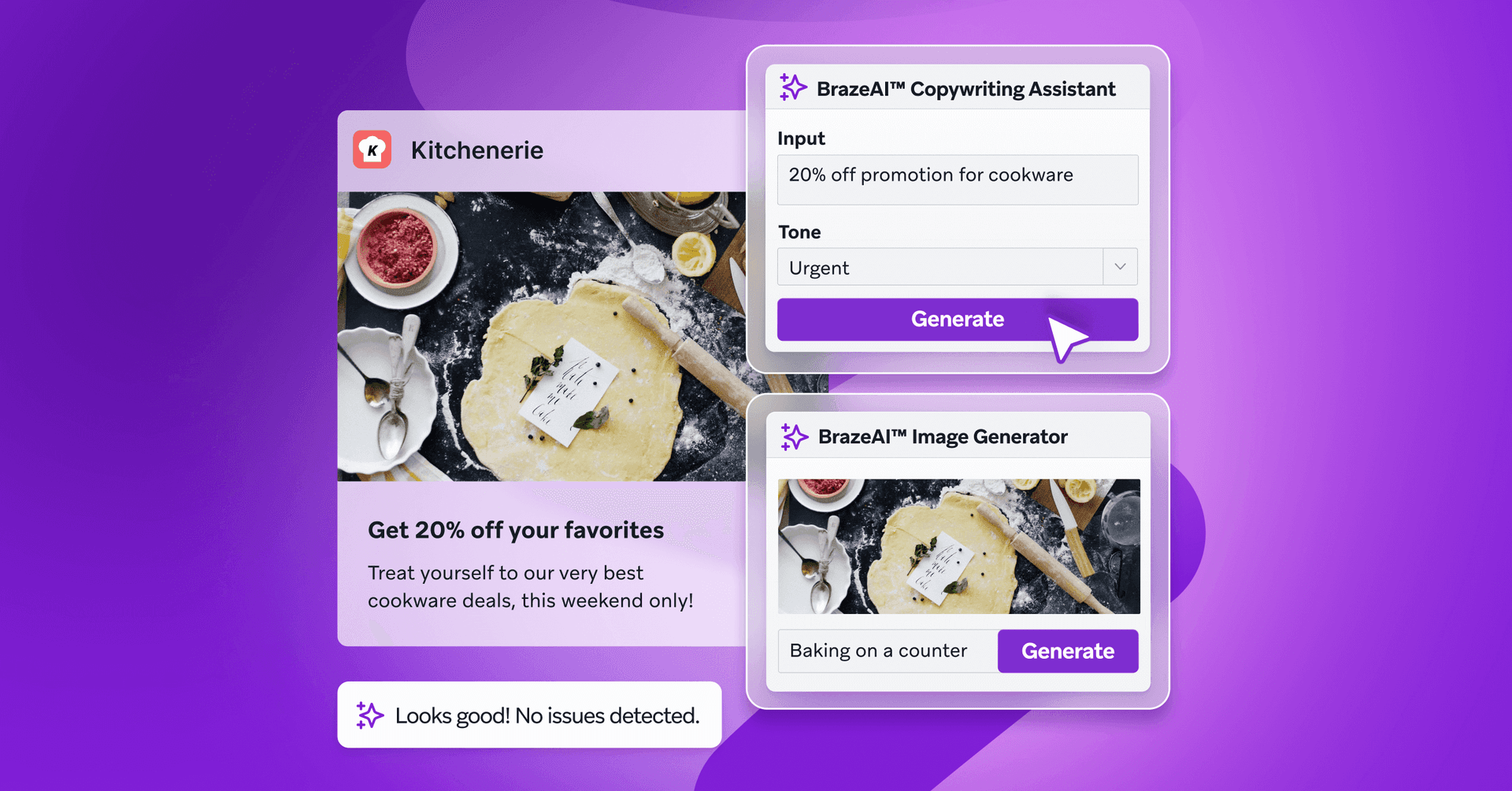
5. Plan for personalization
Personalized emails significantly outperform generic ones. Beyond including the subscriber’s name, leverage customer data to deliver tailored offers, product recommendations, or content that directly speaks to individual needs.
6. Consider cross-channel
Incorporating email into a cross-channel strategy is important for creating a relevant, consistent customer experience. By playing into each channel’s strengths, brands can better engage customers as they move through the lifecycle.
Learn how to build the right channel mix to hit your customer engagement goals—like driving up to 88.3X more purchases per user with a coordinated push, in-app message, email, and SMS strategy.
7. Measure, analyze, and refine
Track key performance metrics like unsubscribes, open rates, click-through rates, and conversion rates. Continuously analyze performance, conduct A/B testing, and refine your strategy based on insights.
Successful marketing campaigns with personalized email examples
At Braze, we’ve helped clients create thousands of successful email campaigns. Below are three of our favorites.
Canva draws a picture-perfect boost in engagement
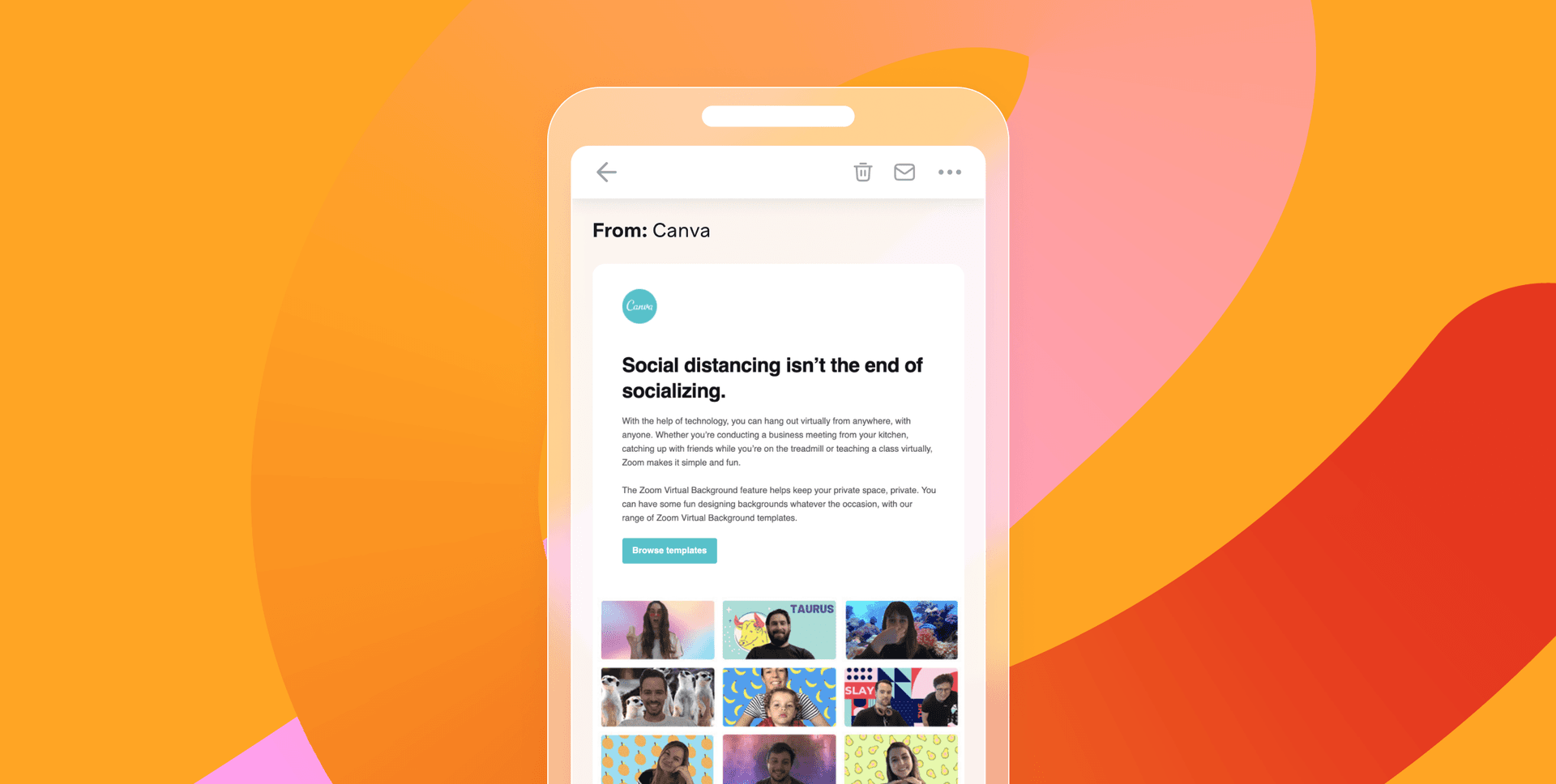
Canva, the global, online graphic design platform helps users to create stunning graphics, presentations, and marketing materials effortlessly. They create messaging in 20 different languages, so being able to communicate quickly, at scale, was always a key focus.
The goal
During 2020, Canva needed to reach millions of people across the world, with helpful, relevant, timely and engaging content. They zeroed in on increasing email sends while maintaining deliverability, and saving time with a new localization strategy.
The solution
Canva used an advanced IP warm up strategy that allowed them to safely and effectively grow email sends from 30 million to 50 million a week. They wanted to maintain their enviable 99% email deliverability, so they cleverly only increased a certain percent each day using a random bucket strategy. They sent email campaigns that had previously been successful, such as top ten trending content, and launched them in leading markets with mini warm ups each week.
The results
Canva’s success maintained 99% email deliverability when doubling down on email volumes, all while increasing open rates by 33%. Platform engagement rate also went up by 2.5%.
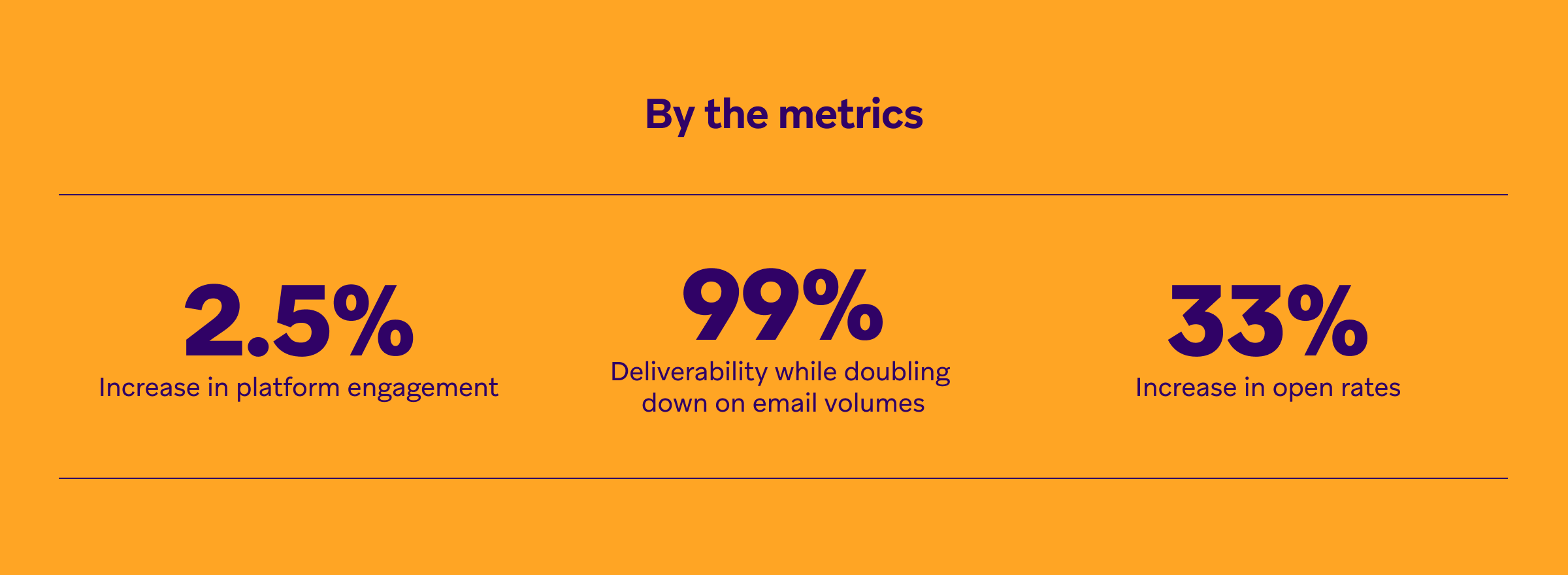
PureGym pumps up open rates with a workout in email marketing
PureGym is the UK's largest gym chain, offering flexible, affordable memberships across numerous locations.
The goal
PureGym sought to enhance member communication by delivering timely, relevant updates about gym services and events, such as closures and improvements, for a better overall member experience.
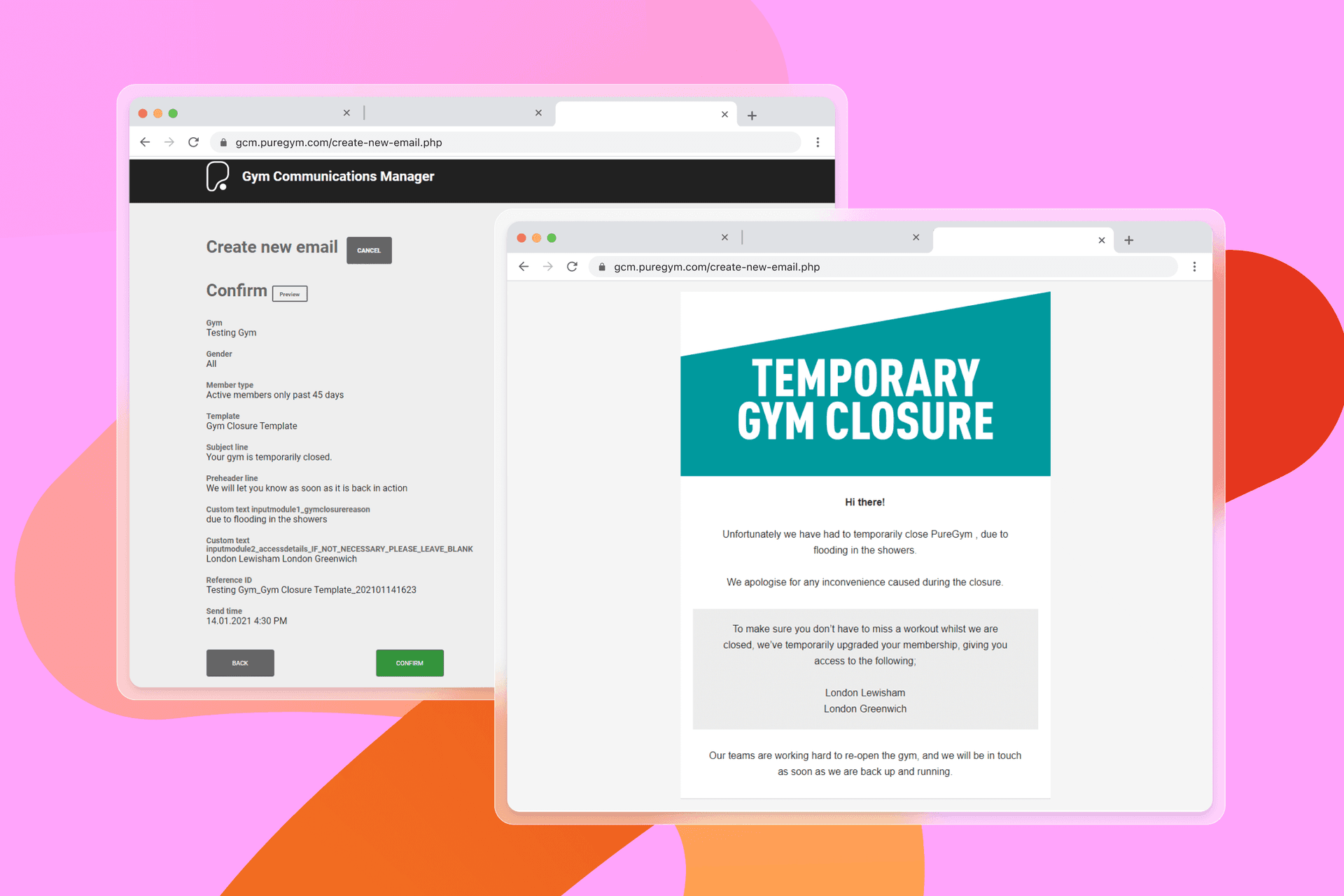
The solution
Collaborating with Braze and ConsultMyApp, PureGym developed the Gym Communications Manager (GCM), integrating to Braze via API to send targeted, location-specific emails. This system allowed for dynamic segmentation and automated messaging, to give members important information promptly.
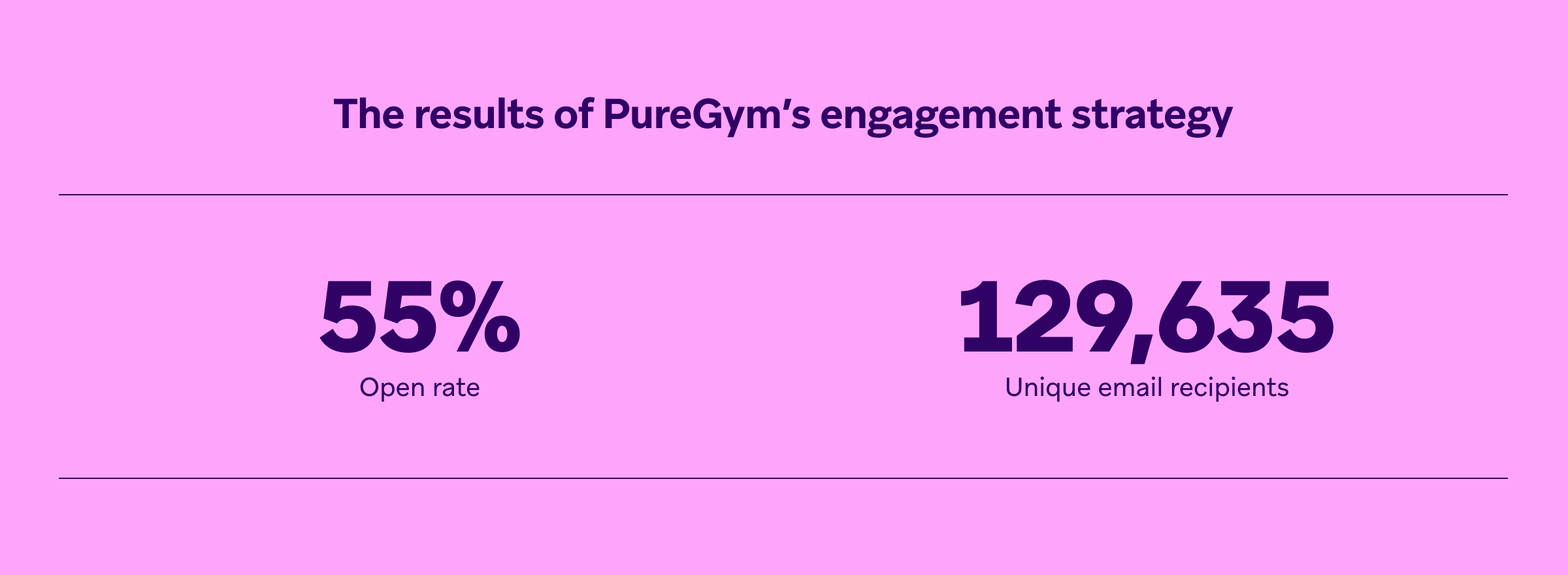
The results
The initiative achieved a 55% email open rate among 129,635 unique recipients, indicating high engagement with the tailored communications.
DraftKings' winning streak through betting on better emails
DraftKings is a premier digital sports entertainment and gaming company, offering daily fantasy sports, sports betting, and online casino gaming.
The goal
DraftKings aimed to enhance user engagement by optimizing email templates for better display across devices, including dark mode and mobile responsiveness, while streamlining the email creation process to save time.
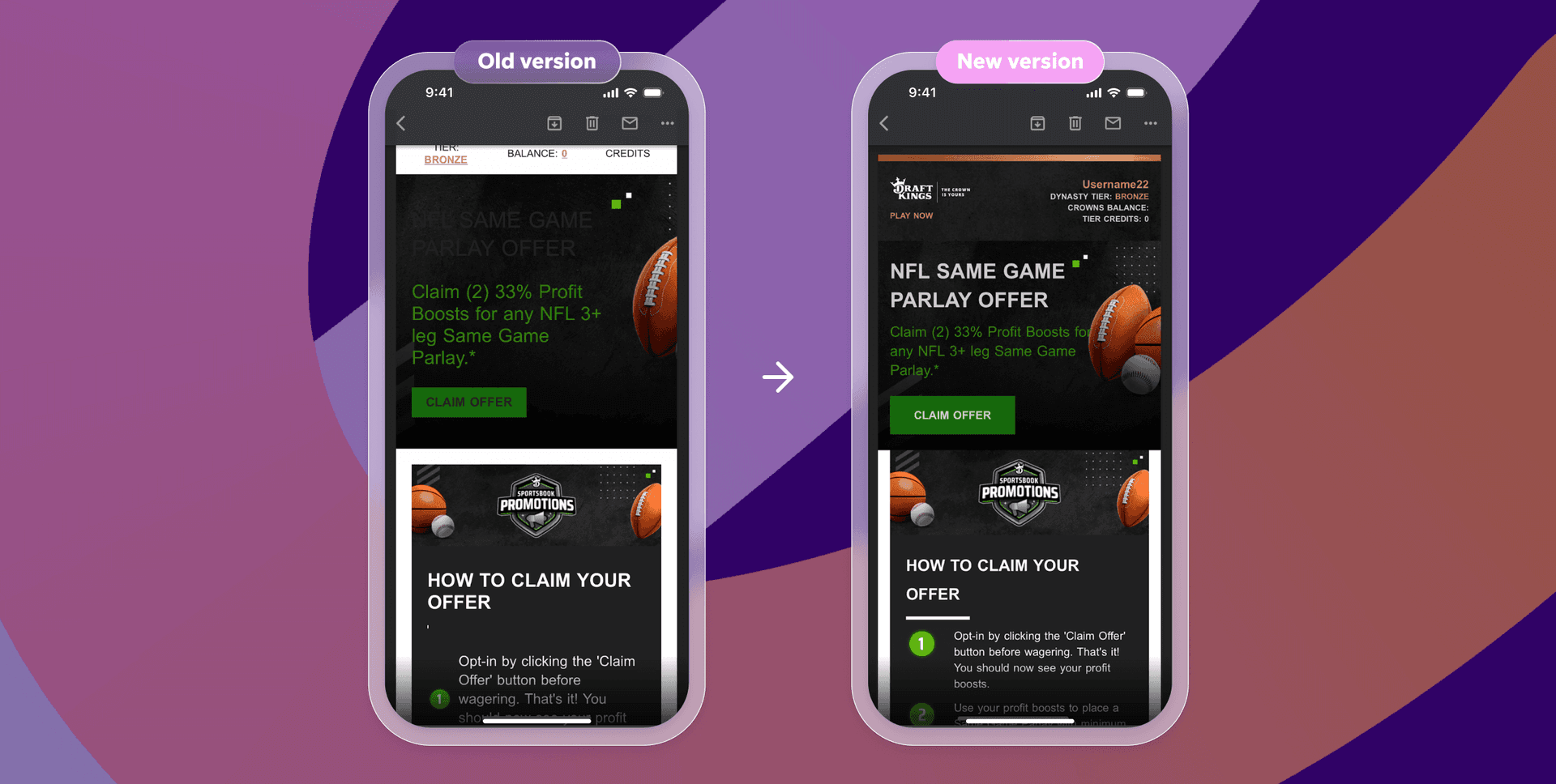
The solution
Partnering with Braze Email Creative Services, DraftKings revamped their email templates to focus on visual and functional improvements for better display across devices and in dark mode. With a dedicated Braze project manager, they were also able to streamline the email creation workflow, reducing the need for external HTML contractors.
The results
The updated templates received positive feedback, with DraftKings anticipating improvements in user engagement metrics and operational efficiency, including saving 4 to 5 hours per week per campaign creator.
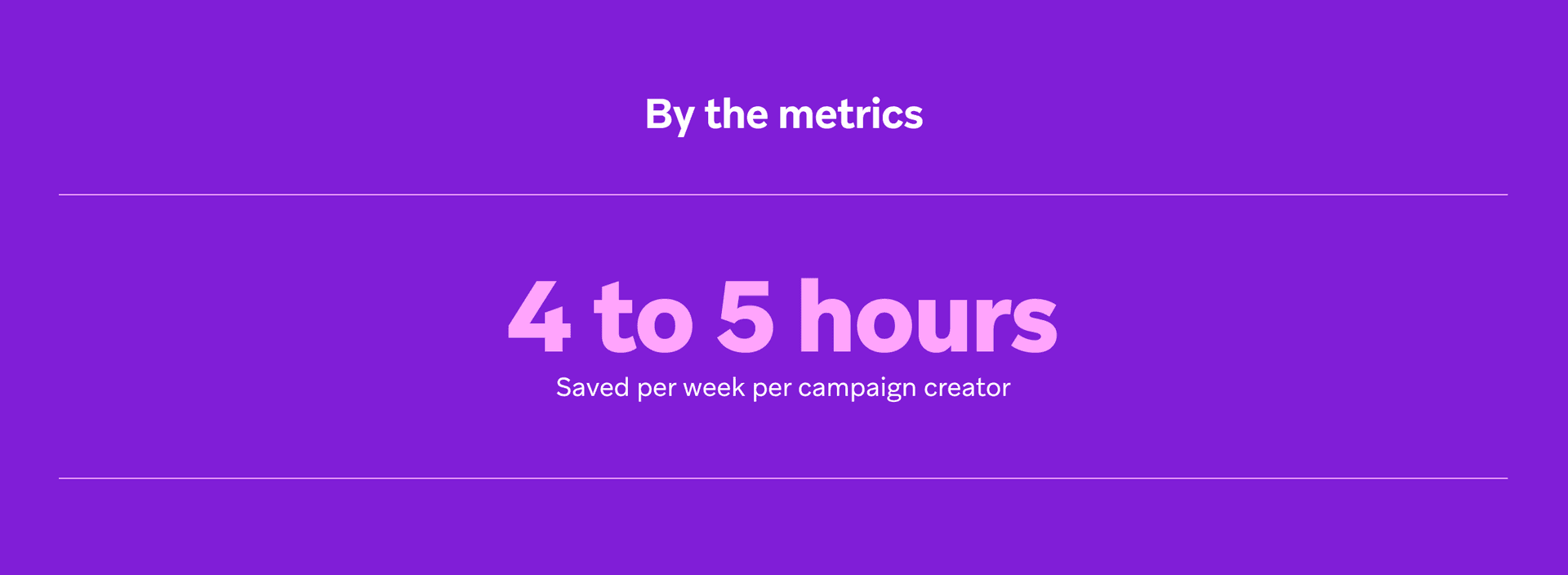
Effective email marketing tips
Following best practices can help email marketers boost their campaign performance and achieve stronger results. Here's what to be aware of:
1. Segmentation strategies
Segmentation is what enables you to deliver relevant messages to the right audiences. You can segment your subscriber list based on demographics, engagement levels, past purchases, preferences, and more. A more tailored message resonates more deeply, and increases opens, clicks, and conversions.
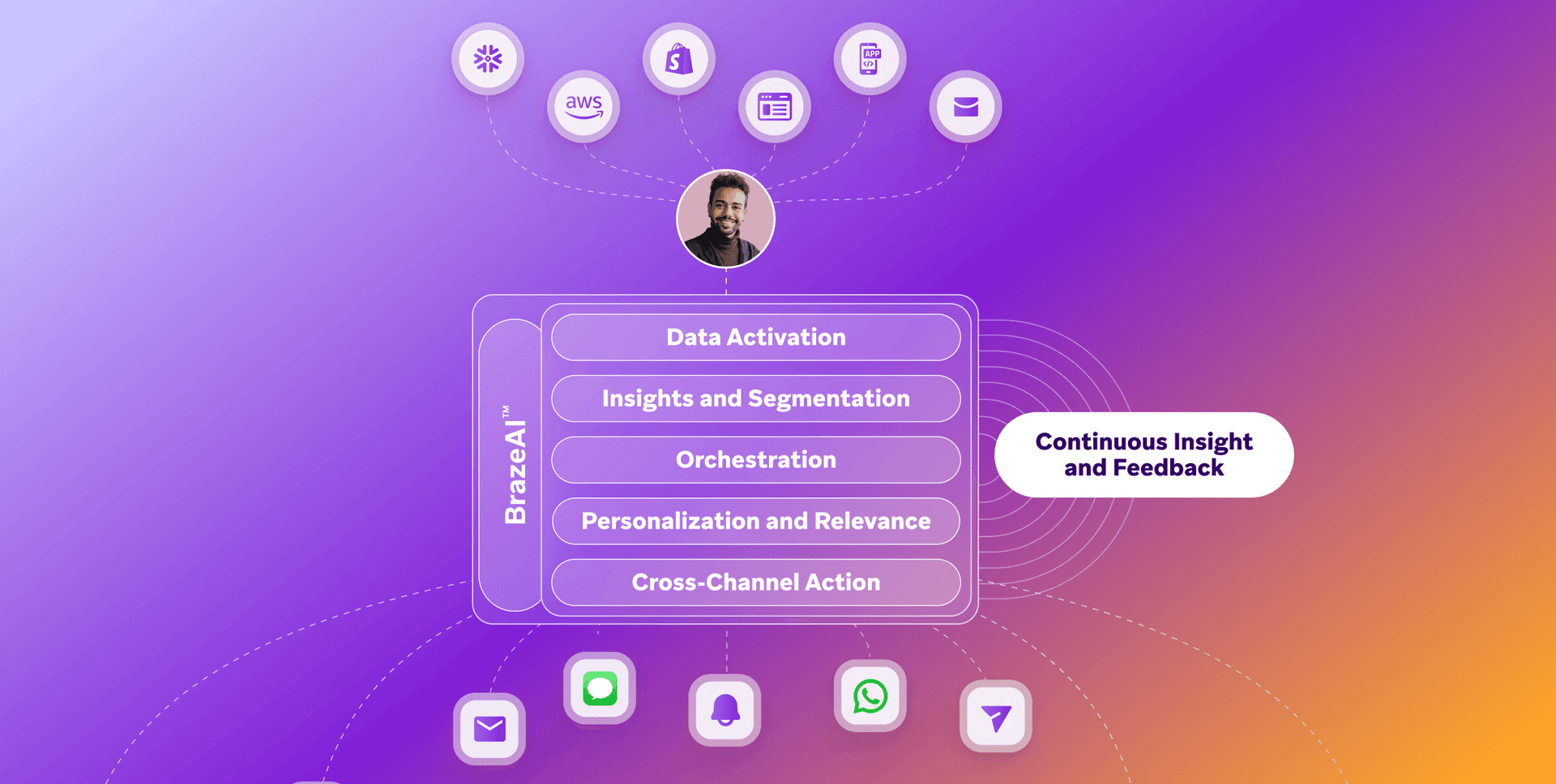
2. Personalization techniques
Go beyond basic name personalization and use behavioral and preference data to customize content, recommendations, and special offers. Personalization makes your subscribers feel valued and helps increase their connection to your brand.
3. A/B testing and optimization
Regularly test your email elements like subject lines, send times, content layouts, landing pages, images, and calls-to-action. A/B testing helps identify what works best for your audience, allowing you to continually optimize for stronger engagement and results.
4. Produce appealing subject lines and preview text
Subject lines and preview text are your first impression. Write concise, intriguing, and benefit-driven copy to compel your subscribers to open your email. Keep subject lines clear, avoid spam triggers, and deliver preview text that enhances your email's appeal.
5. Mobile-first design
With most emails opened on mobile devices, adopting a responsive, mobile-first design is essential. Your emails should look great, load quickly, and function seamlessly on smartphones and tablets to avoid frustrating your audience and losing potential conversions.
6. Clear and actionable CTAs
Every email should include a clear, actionable, and visually appealing call-to-action (CTA). Use concise language that clearly conveys the next step. Position your CTA prominently, making it easy for subscribers to engage.
7. Maintain brand consistency
Your emails should reflect your brand’s visual identity, voice, and overall messaging. Consistency strengthens brand recognition and helps build trust and familiarity, reinforcing your relationship with your subscribers.
8. Build a cross-channel approach
While email is an important channel to communicate with your customers, it’s not the only channel—and it might not be the best channel for the message, either. Create a strategy that uses each channel to the best of its ability and leads to a seamless, valuable customer experience.
How to apply cross-channel marketing email best practices
To apply these best practices effectively across email marketing campaigns, you need to lay the right foundations and build in support. These are the areas to look at and how using Braze can create the right environment for a winning approach.
1. Preparation
Effective preparation sets the foundation for successful email campaigns. Start by clearly defining your goals, whether that's increasing engagement, driving conversions, or building brand loyalty. Develop a content calendar, establish a clear workflow, and have resources and responsibilities clearly allocated.
Use case: A retail brand could use Braze Canvas to plan automated welcome journeys, seasonal promotions, and cart abandonment reminders.
2. Email best practices for list management
Maintaining a healthy email list is critical. Regularly clean your lists to remove inactive or invalid addresses, reducing bounce rates and improving deliverability. Subscribers should always explicitly opt-in, and you need to offer clear unsubscribe options to maintain compliance and trust.
Use case: With regular list maintenance, brands can reduce bounce rates and protecting sender reputation by targeting only real, engaged users.
3. Design and content
Your emails must deliver clear, concise, and visually appealing content. Prioritize readability with short paragraphs, clear headings, and relevant images. Maintain brand consistency through colors, fonts, and overall style to reinforce recognition and trust.
Use case: Use the Braze platform’s drag-and-drop email editor and HTML editor to design visually compelling, brand-consistent emails easily. For instance, a travel brand can build dynamic emails featuring personalized destination recommendations and real-time price updates (via Braze Connected Content.)
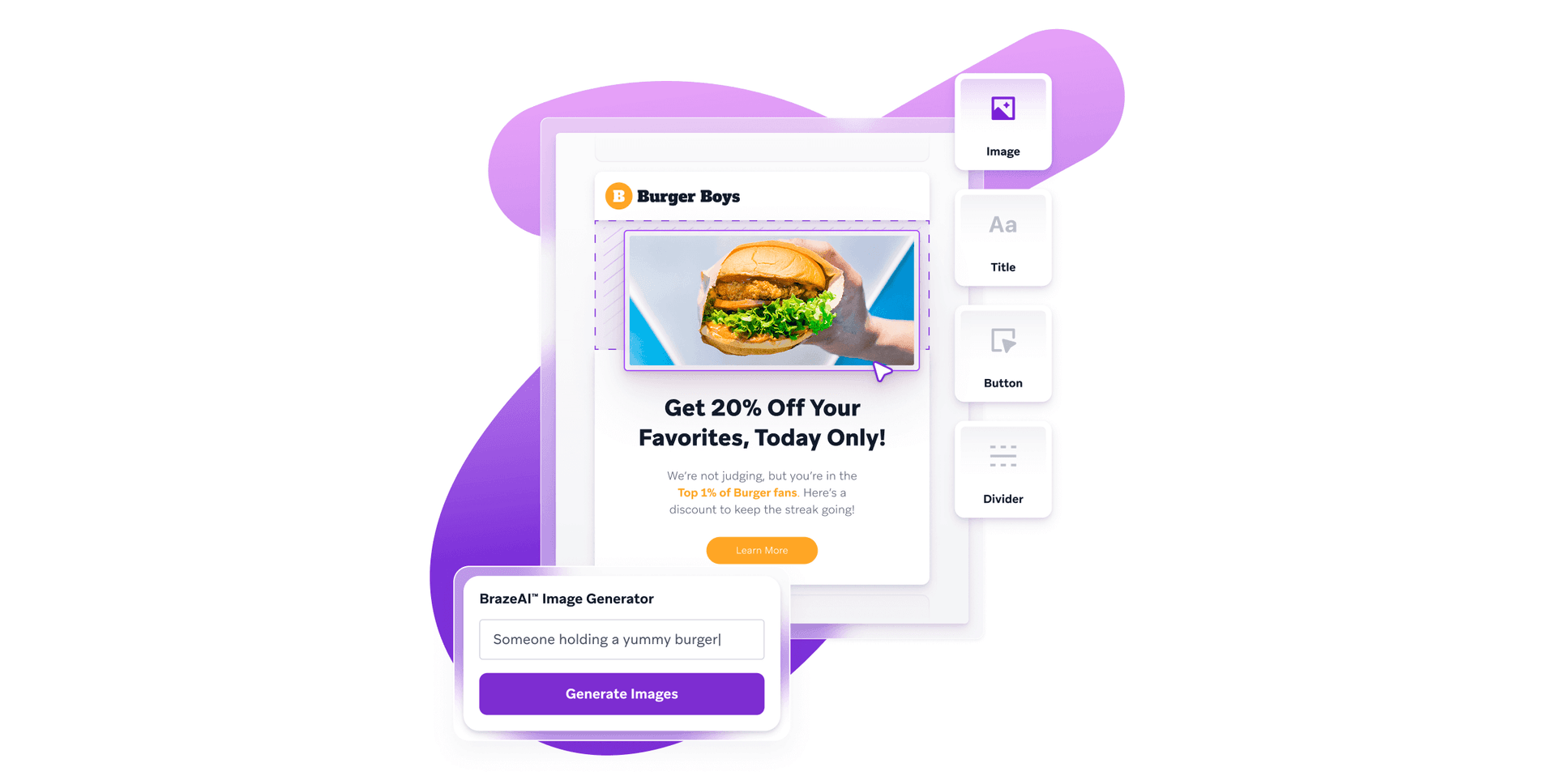
4. Keep an eye to deliverability
Deliverability enables your emails to reach your subscribers' inboxes. Optimize your emails by following authentication protocols like SPF, DKIM, and DMARC. Avoid spam triggers, manage sending frequency responsibly, and regularly monitor performance metrics to quickly identify and address deliverability issues.
Use case: With deliverability tools, such as IP warming and IP pools, help optimize inbox placement. For example, Canva effectively used Braze’s IP warming strategies, safely increasing email sends from 30 million to 50 million weekly while preserving a 99% deliverability rate.
5. Channels
Integrate email into other marketing channels for a seamless customer experience. Choose the right mix of channels for each campaign to increase engagement and improve relevance.
Use case: Create unified experiences across email, push notifications, in-app messaging, SMS, and social media. For example, a fitness app could send an email promoting a workout program, and then send reminders via push notifications and how-to videos via in-app messages for those who join.
Measuring success: Key metrics to track for email campaign optimization
Tracking metrics is essential for evaluating your email campaigns and helps you to continuously improve your strategy. Here are some of the metrics you might want to consider tracking:
1. Open rate
Open rate measures how many recipients open your emails, reflecting the effectiveness of your subject lines and preview text.
2. Click-through rate (CTR)
CTR indicates how many subscribers clicked on links within your emails. High CTR suggests your content and calls-to-action resonate well with your audience, helping you identify effective messaging and offers.
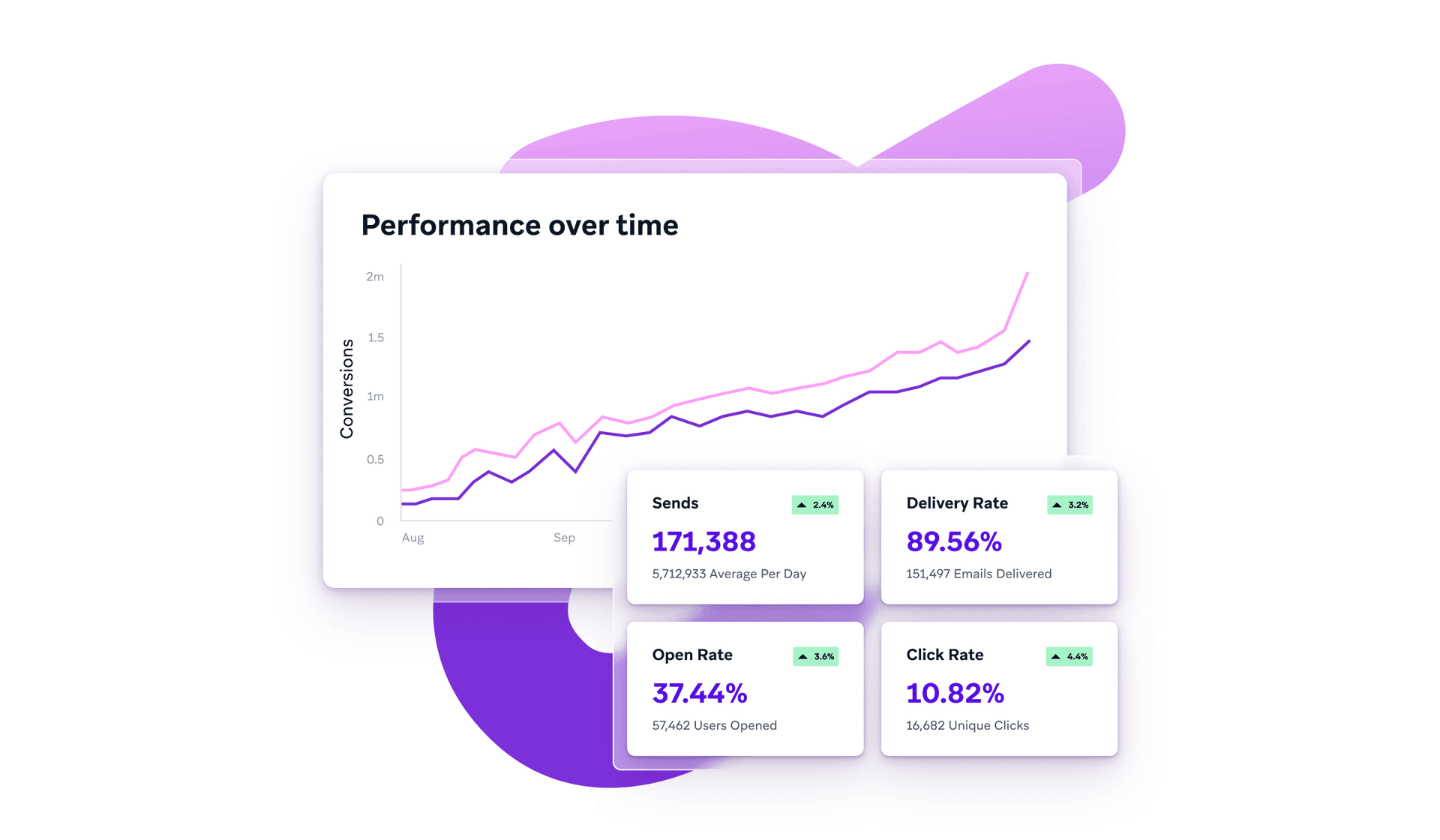
3. Conversion rate
Conversion rate measures the percentage of subscribers who complete a desired action, such as making a purchase or signing up for a webinar. This metric directly reflects your campaign’s impact on your business goals.
4. Bounce rate
Bounce rate tracks emails that didn't reach recipients due to delivery issues. Keeping bounce rates low through good list hygiene and accurate targeting helps protect your sender reputation and maintain or improve deliverability.
5. Unsubscribe rate
Monitoring unsubscribe rates helps you understand audience dissatisfaction or fatigue. High unsubscribe rates indicate potential problems with email frequency, relevance, or content quality.
6. Spam complaint rate
Spam complaints negatively impact deliverability and sender reputation. Regularly tracking spam complaint rates helps you identify content or frequency issues and adjust quickly.
7. Overall ROI
Tracking overall return on investment (ROI) ties email marketing activities to tangible business outcomes. Calculate ROI by comparing the revenue generated from campaigns against the total cost of your email marketing efforts.
Final thoughts
Great email marketing is about creating meaningful moments that build real connections with your audience. By following these best practices—from strategic planning and targeted segmentation to thoughtful personalization and compliance—you can send emails that your subscribers genuinely enjoy receiving.
The best email marketers stay curious. They test, adapt, and continuously learn from their audience, using insights to deliver even better experiences. With Braze, marketers have the flexibility and powerful tools needed to automate smartly, personalize authentically, and turn real-time insights into stronger campaigns.
Forward-Looking Statements
This blog post contains “forward-looking statements” within the meaning of the “safe harbor” provisions of the Private Securities Litigation Reform Act of 1995, including but not limited to, statements regarding the performance of and expected benefits from Braze and its products. These forward-looking statements are based on the current assumptions, expectations and beliefs of Braze, and are subject to substantial risks, uncertainties and changes in circumstances that may cause actual results, performance or achievements to be materially different from any future results, performance or achievements expressed or implied by the forward-looking statements. Further information on potential factors that could affect Braze results are included in the Braze Annual Report on Form 10-K for the fiscal year ended January 31, 2025, filed with the U.S. Securities and Exchange Commission on March 31, 2025, and the other public filings of Braze with the U.S. Securities and Exchange Commission. The forward-looking statements included in this blog post represent the views of Braze only as of the date of this blog post, and Braze assumes no obligation, and does not intend to update these forward-looking statements, except as required by law.
Email marketing FAQs
Email marketing specialists craft, manage, and optimize email marketing campaigns. They are responsible for segmentation, content creation, design, personalization, and deliverability. Specialists analyze campaign performance and refine strategies based on data-driven insights, aiming to boost subscriber engagement and drive measurable results.
The 80/20 rule suggests that 80% of your email content should deliver value, such as educational or entertaining content, while only 20% should directly promote products or services. Following this principle helps maintain subscriber interest, reduces fatigue, and encourages long-term customer loyalty—although it is just a guide, not a set rule.
The golden rule of email marketing is to treat subscribers as you would like to be treated—respectfully, transparently, and thoughtfully. As an email subscriber, you should treat every email as potential spam, being careful with the information you give to others. As an email sender, this means sending relevant, personalized messages at appropriate frequencies, clearly communicating the value of each email, and honoring subscriber preferences and privacy.
Related Tags
Be Absolutely Engaging.™
Sign up for regular updates from Braze.
Related Content
View the Blog
How behavioral marketing turns data into personalized experiences

Team Braze

The new inbox reality: How iOS changes are reshaping email marketing

Aparna Prasad

Experience optimization: Turning data insights into better journeys
